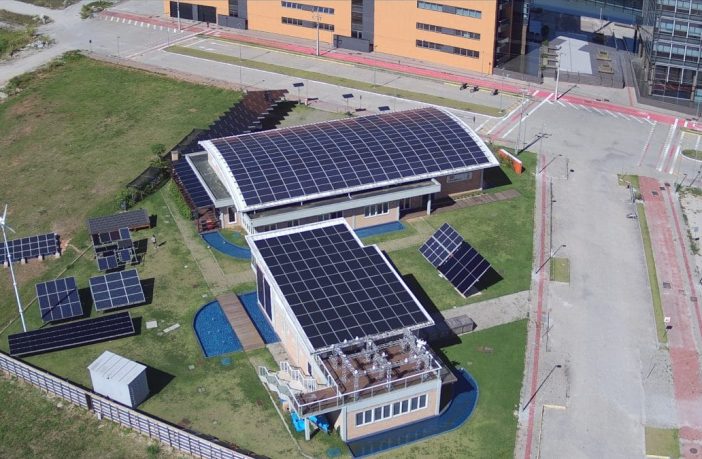- A Brazilian research team has assessed the performance of a PV system installed on the Fotovoltaica/UFSC laboratory, a zero-energy building (ZEB) located in Florianopolis, Brazil, specifying that the solar array was not intended to maximize power production but rather achieve a compromise between the building aesthetics and energy output.
The 111 kW PV system includes several units deployed across two buildings’ rooftops and façades as well as on a carport, a bus shelter/charging station and three small ground-mounted arrays. The installation, which relies on different types of PV module technologies, is also linked to a series of batteries with a combined storage capacity of 260 kWh.
The generated energy is used for building consumption and for powering a small electric bus. The performance of the installations was monitored from August 2017 to February 2020. “Many of the PV systems were installed along this timespan as described, and generation capacity has increased over the period,” the scientists stated.
The analysis included data on solar radiation, changes in the number of the building occupants, upgrades in the installed capacity of the PV systems, the bus usage profile, R&D experiments, occasional requirements for some PV system downtimes, monthly energy generation and consumption, and avoided greenhouse gas (GHG) emissions. The building’s power consumption was calculated with the energy bills and the collected data from the inverters. The methodology used is claimed to be applicable to any location.
The monthly average power generation was found to be 8,414 kWh, while the total power output during the observation period was 260,841 kWh. If all the PV units had operated in full ideal performance, however, the total output could have reached 360,873 kWh. “Considering the ideal energy production, in 2018, the annual PV generation would be 133,215 kWh, with an average of 11,101 kWh/month and, in 2019, the annual PV generation would be 137,865 kWh, with an average of 11,489 kWh/month, some 3% higher than the previous year,” the academics explained.
During the observation period, only 2% of the energy consumed by the building was provided by the local utility Celesc and if all the PV systems had worked at their full capacity this percentage would have been reduced to zero. Around 66% of the energy was consumed by the building and the remaining share was used for powering the small electric bus. “Over the analyzed period, the PV systems supplied 148% of building energy needs, therefore, the Fotovoltaica/UFSC laboratory can be considered not only a ZEB but also a positive energy building (PEB),” the team said. “This case study demonstrated that even when supplying electricity to EVs, urban buildings can be PEBs, an important issue if electromobility is to be adopted more widely.”
The scientists, which come from the Universidade Federal de Santa Catarina (UFSC), the Universidade Federal do Rio Grande do Norte (UFRN), and the Instituto Nacional de Pesquisas Espaciais, presented the results of their research in the paper Energy balance and performance assessment of PV systems installed at a positive-energy building (PEB) solar energy research center, published in Solar Energy
Author: Emiliano Bellini
This article was originally published in pv magazine and is republished with permission.











